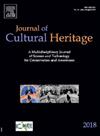The golden Mizunotype—A study of a rare example of Japanese photographic art from the late XIXth century
IF 3.5
2区 综合性期刊
0 ARCHAEOLOGY
引用次数: 0
Abstract
In 2022 the State Museum and Exhibition Center ROSPHOTO received a cultural heritage object of significant interest—a wooden board with three children's portraits created in a rare photographic technique using gold powder.
The performed analysis of the heritage object in combination with a detailed study using a set of complementary scientific methods allowed to clarify several blind spots related to this example of Japanese photographic art: the authorship; the period of time when the portraits were created and a number of technological aspects applied to the image during its production.
The set of scientific methods, namely optical microscopy, X-ray fluorescence analysis, infrared spectroscopy and anatomical wood examination, was applied to the object in order to determine the content and technique of rare photographic image as well as to identify the wood type used as the base. It was found that the studied image was made via unique and rarely seen gold mizunotype technique and the portraits were created on the wooden board made of Chamaecyparis obtusa, also called Japanese cypress or Hinoki. To the best of our knowledge no detailed scientific and comprehensive study was performed for these XIX–XXth century Japanese photographic art relics. Such objects are one-of-a-kind exhibit, that is why the opportunity to come into contact with such artifacts is a huge success for all—art historians, curators and researchers.
金色水版--对十九世纪末日本摄影艺术珍品的研究
2022 年,国立博物馆和展览中心 ROSPHOTO 接收了一件具有重要意义的文化遗产--一块木板上的三幅儿童肖像画,这是用罕见的金粉摄影技术创作的。为了确定珍稀摄影图像的内容和技术,以及确定用作底座的木材类型,我们对该文物采用了一套科学方法,即光学显微镜、X 射线荧光分析、红外光谱和解剖木材检查。研究发现,所研究的图像是通过独特且罕见的金色水印技术制作的,肖像是在由 Chamaecyparis obtusa(又称日本扁柏或桧木)制成的木板上创作的。据我们所知,对这些十九至二十世纪的日本摄影艺术文物还没有进行过详细的科学和综合研究。此类文物是独一无二的展品,因此,对于所有艺术史学家、策展人和研究人员来说,有机会接触此类文物是一次巨大的成功。
本文章由计算机程序翻译,如有差异,请以英文原文为准。
求助全文
约1分钟内获得全文
求助全文
来源期刊

Journal of Cultural Heritage
综合性期刊-材料科学:综合
CiteScore
6.80
自引率
9.70%
发文量
166
审稿时长
52 days
期刊介绍:
The Journal of Cultural Heritage publishes original papers which comprise previously unpublished data and present innovative methods concerning all aspects of science and technology of cultural heritage as well as interpretation and theoretical issues related to preservation.
 求助内容:
求助内容: 应助结果提醒方式:
应助结果提醒方式:


